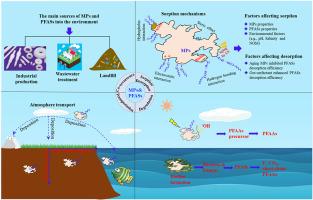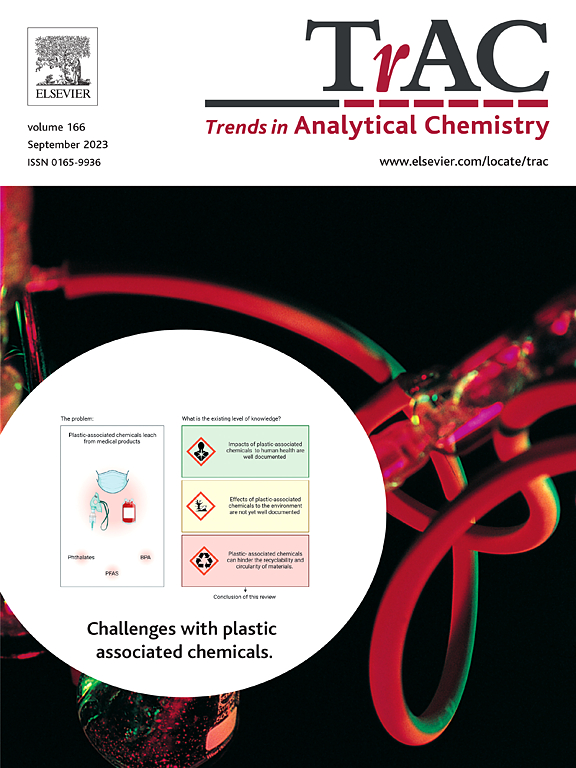The role of microplastics as carriers of per- and polyfluoroalkyl substances and their fate in the environment
IF 11.8
1区 化学
Q1 CHEMISTRY, ANALYTICAL
引用次数: 0
Abstract
Microplastics (MPs) and per- and polyfluoroalkyl substances (PFASs) co-contamination in varying environmental ecosystems is becoming a topic of serious concern due to their widespread presence and persistence in the environment. However, their interaction in the environment has not been understood yet, requiring immediate consideration. This review aims to comprehensively explore the co-sources of PFASs and MPs co-contamination, and their associated interactions in the environment. The co-sources of PFASs and MPs are crucial for proposing appropriate regulations on releasing these contaminants. This study exposes all sources leading to their co-contamination. In addition, several mechanisms, including electrostatic interaction, hydrophobic interaction, hydrogen bonding, and steric effect were the main sorption mechanisms involved in the co-contamination of PFASs and MPs. It was confirmed that the physicochemical properties of the MPs and PFASs, as well as the environmental conditions, play crucial roles in determining the sorption or desorption capacity of PFASs onto MPs. It has been reported that PFASs are more easily adsorbed by biodegradable MPs than conventional MPs. Similarly, the weathering of MPs through the formation of biofilms increases the PFASs sorption capacity by 20–85 % compared to that over virgin MPs. A decreasing trend in PFASs desorption was found in the aged MPs, whereas the desorption rate increased under simulated gastric and intestinal conditions. Moreover, the potential transportation pathways of the sorbed PFASs over MPs in the environment, including atmosphere, soil, and marine ecosystems were proposed. Last but not least, biofilm-covered MPs seem to provide active sites for PFASs biodegradation through the co-metabolism action of bacteria and fungi. Besides, various challenges need to be addressed to understand the mechanisms of the co-contamination of PFASs and MPs, and future research perspectives were provided to further improve the basic understanding and remedial measures for the co-contamination of PFASs and MPs.

微塑料作为全氟和多氟烷基物质载体的作用及其在环境中的归宿
由于微塑料(MPs)和全氟烷基及多氟烷基物质(PFASs)在环境中的广泛存在和持久性,它们在不同环境生态系统中的共同污染正成为一个令人严重关切的问题。然而,人们对它们在环境中的相互作用还不甚了解,需要立即加以考虑。本综述旨在全面探讨 PFASs 和 MPs 共同污染的共同来源及其在环境中的相关相互作用。PFASs 和 MPs 的共同来源对于提出适当的污染物排放法规至关重要。本研究揭示了导致它们共同污染的所有来源。此外,包括静电作用、疏水作用、氢键和立体效应在内的几种机制是 PFAS 和 MPs 共同污染的主要吸附机制。研究证实,MPs 和 PFASs 的理化性质以及环境条件对 PFASs 在 MPs 上的吸附或解吸能力起着至关重要的作用。据报道,与传统 MP 相比,可生物降解的 MP 更容易吸附 PFAS。同样,通过形成生物膜对 MPs 进行风化,PFASs 的吸附能力比原始 MPs 提高了 20-85%。老化的 MPs 对 PFASs 的解吸附呈下降趋势,而在模拟胃肠条件下,解吸附率则有所上升。此外,还提出了吸附在 MPs 上的 PFAS 在大气、土壤和海洋生态系统等环境中的潜在迁移途径。最后但并非最不重要的一点是,生物膜覆盖的 MPs 似乎通过细菌和真菌的协同代谢作用为 PFASs 的生物降解提供了活性位点。此外,要了解 PFASs 和 MPs 共同污染的机理,还需要应对各种挑战,并提出了未来的研究前景,以进一步提高对 PFASs 和 MPs 共同污染的基本认识和补救措施。
本文章由计算机程序翻译,如有差异,请以英文原文为准。
求助全文
约1分钟内获得全文
求助全文
来源期刊

Trends in Analytical Chemistry
化学-分析化学
CiteScore
20.00
自引率
4.60%
发文量
257
审稿时长
3.4 months
期刊介绍:
TrAC publishes succinct and critical overviews of recent advancements in analytical chemistry, designed to assist analytical chemists and other users of analytical techniques. These reviews offer excellent, up-to-date, and timely coverage of various topics within analytical chemistry. Encompassing areas such as analytical instrumentation, biomedical analysis, biomolecular analysis, biosensors, chemical analysis, chemometrics, clinical chemistry, drug discovery, environmental analysis and monitoring, food analysis, forensic science, laboratory automation, materials science, metabolomics, pesticide-residue analysis, pharmaceutical analysis, proteomics, surface science, and water analysis and monitoring, these critical reviews provide comprehensive insights for practitioners in the field.
 求助内容:
求助内容: 应助结果提醒方式:
应助结果提醒方式:


